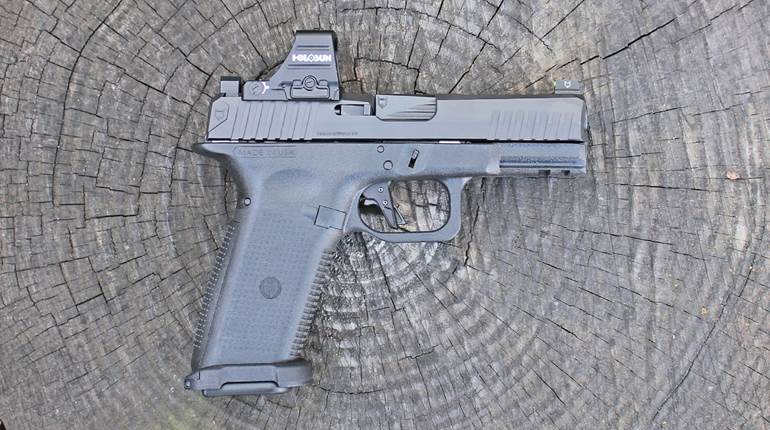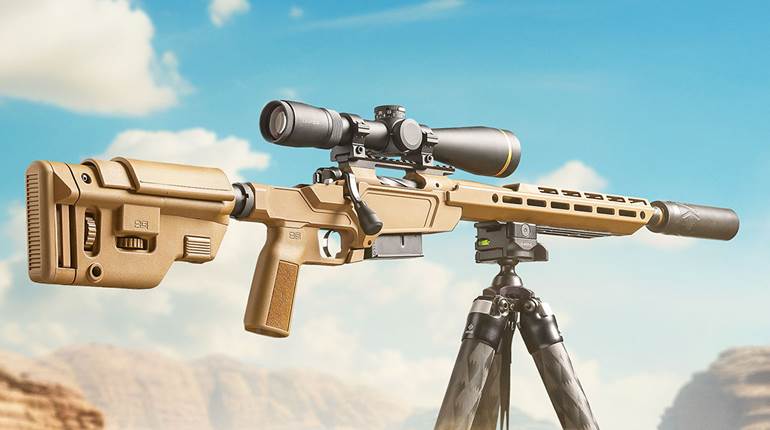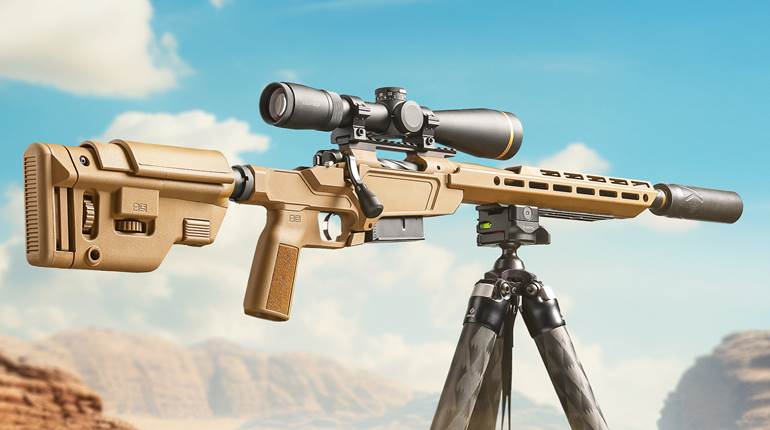
Have you ever worked a slick, modern, straight-pull action? Flick, flick, ready! The most touted advantage to the straight-pull bolt-action is speed. That it has, but that’s only half the advantage: The straight-pull action allows operation with less arm and hand movement and requires less strength—thus less sight-picture interruption—than is possible with a turnbolt. In Europe, straight-pull actions are near-dominant. This is because of the widespread popularity of the driven hunt. Most shots are at moving game; the speed of repeat shots matters, and semi-automatics are not allowed in many countries across the pond. The straight-pull developed as the next best thing.
Today’s straight-pull rifles are mostly modern actions of recent design, but the straight-pull bolt-action is hardly new. In the 1880s, straight-pulls were a parallel development with the perfection of the turnbolt. The rotating-bolt design became more prevalent, but several straight-pull actions were adopted by militaries, notably the Mannlicher (Austro-Hungarian Empire, 1886); Schmidt (Switzerland, 1889); Lee (U.S. Navy, 1895); and Ross (Canada, 1905). The Swiss Schmidt-Rubin series (action by Rudolf Schmidt, cartridge by Eduard Rubin) was the most successful and enduring, with the final K31 straight-pull rifle remaining in service until 1970; the other three didn’t make it beyond World War I, the general consensus being that rotating bolts were less expensive to manufacture, more rugged and simpler.
This was all true a century ago, but it doesn’t still hold water given modern metallurgy and manufacturing processes. Blaser’s R93 was probably the first successful modern straight-pull, with some 200,000 produced between 1993 and 2017, when it was completely discontinued in favor of the R8, also popular and very much still in production, with more than 100,000 R8s to date. Considering cost and the fact that most sales are in Europe, these are high numbers, attesting to the straight-pull’s popularity over there.
HYBRID STRAIGHT-PULL
Americans have been slower to embrace the concept. Several excellent European straight-pulls aren’t marketed at all over here, and American shooters have little knowledge and no experience with them as a result. There are several possible reasons: First, many European straight-pulls are “fine guns,” much costlier than domestic turnbolts. Second, naturally, most are European in style, appealing to some American shooters, but unfamiliar to many. Third, aftermarket support and options are often limited. The new Strasser RS 700 is different; it is not an inexpensive rifle, but it makes great strides in answering the last two reservations. The RS 700 is a premium-quality, Austrian-made straight-pull. The basic action is similar to Strasser’s RS 14, locking up via four radial lugs in the bolt that are forced outward to mate with matching recesses in the barrel when the bolt handle is pushed forward. When the bolt handle is pulled back, the lugs retract into the bolt body—smooth and fast, forward and back.
Unlike the RS 14, the RS 700 is not a switch-barrel rifle. Also, it carries an all-American lineage, which is why its model number is no coincidence. The RS 700 shares key features—and dimensions—with the most popular production turnbolt of all time: Remington’s Model 700. Strasser describes it as having the “Remington 700 footprint,” including compatibility with short-action 700 stocks, barrels and trigger assemblies. It is a good lineage and one that changes the game for parts compatibility and aftermarket support. But, remember, the Strasser is not a Remington 700, nor a turnbolt action at all; it’s a fully ambidextrous straight-pull. This last quality probably isn’t important to most of the right-handed majority, but it is important to us lefties—and could be to you if you have southpaws in your family. All bolt-actions are best operated from the correct (strong) side, but straight-pulls are especially awkward and slow if operated from the wrong side (as in, by lefties using a right-hand bolt). On the RS 700, even the stock is set up for ambidextrous use. For left-hand operation, just pop in a left-hand bolt. The receiver is an open bridge, ejecting right with a right-hand bolt or left with left-hand bolt. The magazine release is in the forward bow of the trigger guard, positive and goof-proof.

Other controls, at the right rear of the receiver, include a two-position safety and a bolt release. Since a straight-pull bolt rides above the stock, there is no need for a bolt handle cutout. Although the Remington M700 was long offered in a generous selection of mirror-image versions (as a left-handed shooter, I have owned a bunch of them), the numbers game suggests that about 85 percent of all Remington 700 stocks—factory, aftermarket and custom—have a bolt handle cutout on the right side. The Strasser RS 700 cleverly uses this cutout to house the bolt release, a knurled knob pulled straight down to release the bolt. For use with left-hand stocks, the bolt release can be switched to the left side. With its linkage to the Remington 700, this new Strasser is thus a hybrid of old and new; Strasser likes to call the RS 700 the “rebirth of a legend.”
TEST RIFLE
RS 700 rifles are just making their way into the United States. There are several configurations, including Legend models with traditional walnut stocks and AVA-Tahr versions in carbon-fiber stocks with an adjustable comb—these with flush-fit, three-round, in-line magazines. Also offered is an XRS Chassis long-range variant, with a carbon-fiber stock with an adjustable cheekpiece and an extended five-round magazine. All three have an integral M-Lok rail near the end of the fore-end. All Strasser rifles feature top-quality hammer-forged barrels and carry a 12-year warranty.
My test RS 700 arrived stocked in a modern American tactical-style stock with a near-vertical pistol grip, a high, straight comb and a flat-bottomed fore-end featuring a Picatinny rail strip with M-Lok in lieu of a forward sling swivel stud. The stock was painted a black/gray camouflage pattern called Alpine Tungsten; Alpine Green is another option. The rifle came with a Picatinny rail scope mount, a 5.5" strip mounted over the receiver. Although light carbon fiber, the stock is beefy in dimension with minimal drop at comb and heel, clearly intended for use with larger scopes requiring higher mounts. Although not adjustable and sans cheekpiece, the stock is dead-straight and fully ambidextrous. Good thing, because I requested a left-hand bolt. Hard to get a proper feel for any rifle if one must operate it from the wrong side … especially a straight-pull.
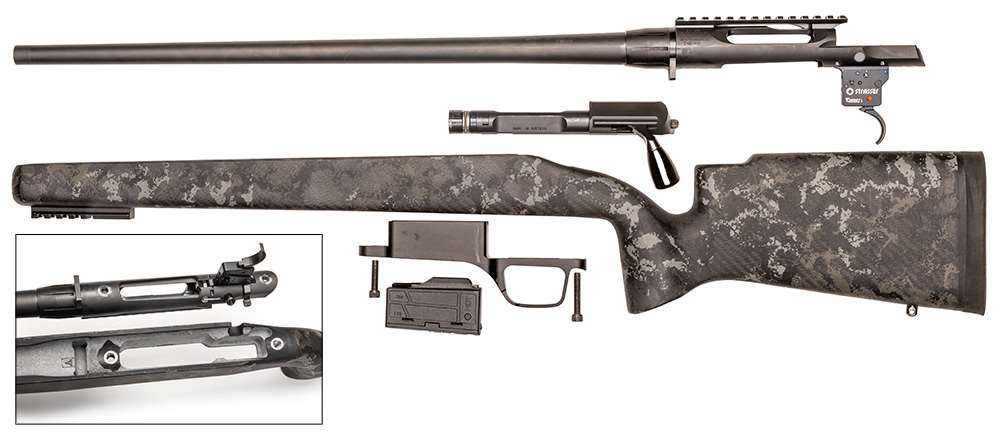
The barrel is bedded to aluminum pillars in the stock and mated to the receiver with a Remage-style barrel nut. This is not a system used on all versions of the Remington 700, but is commonly used. Initial chamberings include 6.5 mm Creedmoor and .308 Winchester in 22" barrel lengths, with a magnum offering in 6.5 mm PRC with a 24" barrel, all of which are dimensionally compatible with Model 700 short-action stocks for bedding. Cold-hammer-forged barrels are sourced from Lothar Walther and are medium in contour. Both the action and barrel are finished with hardened PlasOx nitride. The supplied three-shot polymer magazine fits flush, detaches easily and locks in securely; all AICS-pattern magazines are compatible.
The test rifle was in 6.5 mm Creedmoor. I mounted a Zeiss Conquest 4.5-14X 50 mm 1" scope in medium Weaver rings. Cheek weld was fine, but the high, straight comb would have allowed for a larger scope in higher rings.

The action was smooth, easy to get the feel of and wonderfully fast. There is a cocking indicator, a small tab that extends at the rear of the bolt when the action is cocked and ready to fire. Otherwise, operation was straightforward with consistent and trouble-free feeding, extraction and ejection. Funny, with most unfamiliar rifles, getting a feel for the bolt release takes some fumbling. This bolt release is obviously different, but it works like a charm and is said to be almost bullet-proof. Except, with the high comb on this stock, there’s almost no clearance between the rear of bolt and the stock when the action is open. So, to remove the bolt, I quickly learned that I needed to pull the bolt back, work the release, then pull the bolt a wee bit farther back and lift it upward to clear the stock.
RANGE AND FIELD
For accuracy testing, I started with Federal 140-grain Fusion, Hornady 140-grain American Gunner and Remington 129-grain Core-Lokt Tipped loads. Results from five-shot, 100-yard groups were exceptionally consistent: no dramatically tiny groups, but also no atrocious groups. There was a scattering of m.o.a. groups with all three loads (the best group with Hornady was essentially “there” at 1.02"). The two largest groups, one from the Hornady and the other from the Federal load, measured the same at 2.05". Best results, on this day, in this rifle’s barrel, were with Remington Core-Lokt Tipped, a relatively new bullet, with a five-group average of a very acceptable 1.3". Overall, I was pleased with the results, an average of 1.43" across 15 five-shot groups with three different loads—solidly sub-1.5 m.o.a.
Because of its popularity and current legend, we tend to expect great things out of a 6.5 mm Creedmoor-chambered rifle. It is an inherently accurate cartridge, but it is not magic, and it is still subject to the vagaries of individual barrels. Much depends on the ammo … and what a given rifle shoots best.
Opinions vary on barrels, but I think hammer-forging is the most consistent barrel-making technique, and Lothar Walther makes awesome barrels. You never know, but I don’t expect a brand-new rifle, fresh out of the box, to shoot the best it’s going to shoot. The loads I had to start with were all good quality, but none were premium or match-grade.
The way I run the test protocol, not being a patient guy, I try to avoid hot summer days, so I don’t have to wait forever for a barrel to cool. Anyway, I always let the barrel cool down between groups, and I clean between loads. Usually, I do the chronographing last because that’s a lot of groups to shoot at once. Not a problem with a mild-kicking cartridge like the Creedmoor, but it’s still a lot of groups, and it can be impossible to be certain which uncalled fliers were caused by the shooter, the rifle or the cartridge.
After initial zeroing, 15 groups (75 shots) “for score,” plus strings across the chronograph, I had more than 100 rounds through the barrel, so we can conclude that it was pretty well “broken in.” I don’t always have the time, ammunition or even desire to revisit a gun after I finish with my testing, but I intended to hunt with this rifle, so I took it to the range a second time. I didn’t have enough Creedmoor ammunition on hand to re-run the full protocol, but I had plenty to check zero and fire a few groups. This time, it grouped a bit better with the Hornady load—about the same as the Federal Fusions and Remington Core-Lokt Tippeds. I also found a partial box of Hornady’s 120-grain ELD Match load. After sending five downrange, four shots were touching at just under 0.5 m.o.a.—then a flier opened the group to 1.25".

On the bench, I loved this rifle. The action was smooth and, like all straight-pulls, very quick. On the RS 700, Strasser uses Timney’s excellent Elite Hunter trigger (Remington 700-compatible), which, out of the box, broke at a bit more than 2 lbs. Combined with a decent gun weight of 7 lbs., 8 ozs., and mild 6.5 mm Creedmoor recoil, shooting groups was a pleasure. This Timney is easily adjustable between 2 lbs. and 4 lbs., and while the lower end may be light for hunting, it is awesome for shooting groups, so I left it alone.
There was one small exception to my overall happiness with the gun: The ejection ports (on both sides) require that single-loading into the chamber takes a bit of fumbling and can result in dropped cartridges, especially at first. While shooting groups, I quickly found it easier to load from the magazine. In retrospect, this was probably a good exercise: Feeding and cycling from the magazine was flawless.

Range work all done, I took the rifle whitetail hunting on my son-in-law’s Texas ranch. I wouldn’t be hunting big bucks; we’re trying to improve quality, so we’d be looking for ugly “management” bucks. I’ve long thought Remington’s Core-Lokt bullet was one of the very best factory-loaded hunting bullets. No telling how many millions of deer Core-Lokts have accounted for, but I hadn’t yet hunted with the new polymer-tipped version. I figured it should open a bit quicker, but should hold together, and the lighter 129-grain 6.5 mm in the Creedmoor should be fine for our small-bodied Texas deer.
As for the rifle, I had no concerns whatsoever. I haven’t used “all” the various straight-pull actions, but, provided the bolt is on the proper side, I’m very comfortable with rifles of this type. I bought a Blaser R8 back in 2011 and later got another for my wife, Donna. She’s also left-handed, so both have left-hand bolts. We’ve used them all over the place, for a wide variety of game. After a lifetime of operating rotating-bolt actions, a straight-pull takes getting used to, but once you get the hang of it, the fast operation with less movement is wonderful.
In hunting situations, the extra speed isn’t always needed, but it’s there. After years of using the Blaser system, I’m comfortable with the cocking lever safety common to most straight-pulls I’ve encountered. However, I also use a lot of rotating-bolt actions and have even more experience with Remington 700s. So, I appreciated the familiar back-and-forth two-position safety.
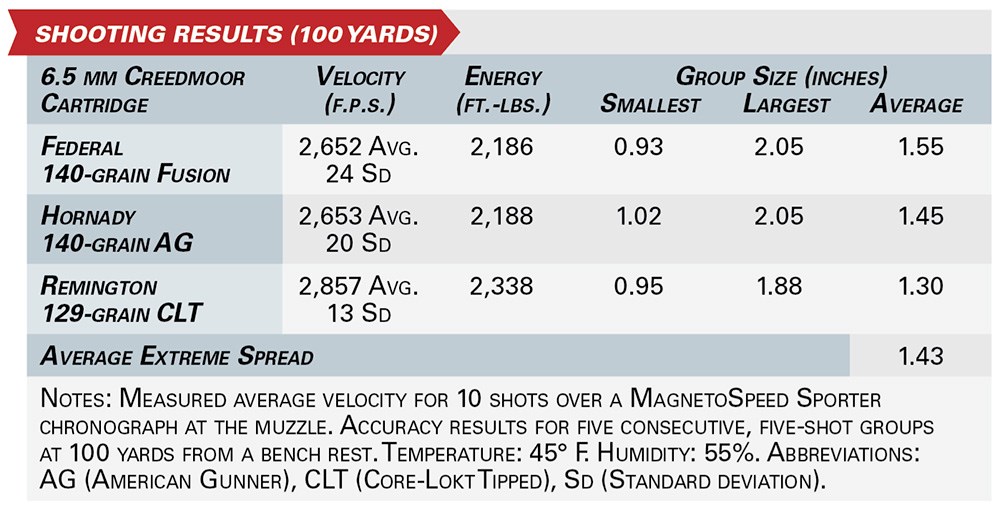
Hunting with young Ethan Cook, we looked over a lot of bucks that were too perfect, too big or too young. Every year “bad bucks” get scarcer—after all, that’s the idea, right? Hunting from a blind, we passed on several nice bucks, then a badly mismatched three-by-two came in. With a steady rest, at about 100 yards, I shot, and the buck ran hard. We were certain we heard him crash, and, sure enough, we found him 50 yards into the mesquite.
Another opportunity came in a chance encounter, two bucks standing down a sendero at 200 yards. The buck on the right appeared to be exactly the kind of buck we don’t want: a normal Hill Country eight-pointer on his right antler, but just a brow point and long spike on his left. We took a few extra moments to make sure the left antler was truly slick, points absent rather than broken from fighting. I used those seconds to get on him while Ethan made the call. By the time we were sure he was a shooter, I was ready, so I pressed the light trigger. The shot looked good and felt good, and the buck went down about the same 50 yards into the brush.
I flicked the bolt and was ready to fire again, but straight-pull speed wasn’t needed; the shots looked good and were. These are not large-bodied deer, but I was delighted to see that the 129-grain Core-Lokt Tipped entered, broke shoulders and exited. Wound channels showed good expansion, absent major meat damage. It seemed to work like a good ole Core-Lokt.
In all, whether in the field or at the range, the Strasser felt good and handled well. The company’s slogan is “passionate innovation.” Why? Maybe because shooters who have adopted straight-pull actions tend to be passionate about them. Despite straight-pull bolt-actions having been around since the 1880s, the Strasser RS 700 is genuinely innovative. A modern straight-pull with familiar roots, this rifle could change American shooters’ perceptions on the platform as a whole.













